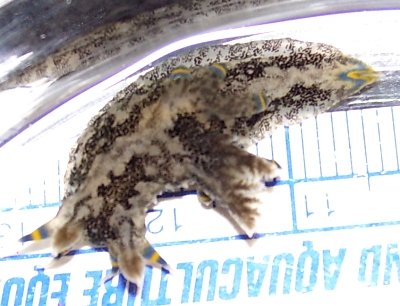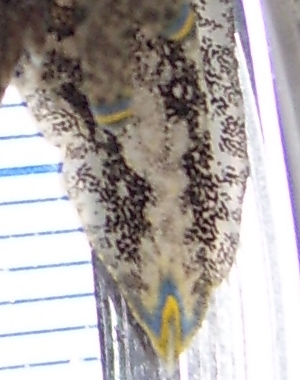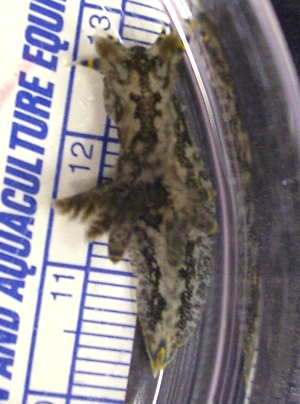Polycera hummi from North Carolina
November 22, 2006
From: Tony Fernando

Hello Dr. Rudman,
Attached please find photos of our specimen of Polycera hummi. Collection was made during routine cleaning of an upweller receiving raw seawater from Bogue Sound.
Locality: Morehead City, collected in upweller, North Carolina, USA, Bogue Sound, 9 November 2006. Length: 25 mm. Photographer: Tony Fernando.
Unfortunately I didn't attempt to identify the animal until about a week after capture, so I lost the oportunity to do fecal assesment to determine it's food in the "wild". The animal is currently in isolation, and we will present it with local Bryozoan sp. to confirm the suspected feeding behavior.
I have requested the 1952 and 1980 papers which mention the animal (I already have the 1961 Marcus paper)... other than looking at laboratory feeding, off the top of your head is there anything else we should be looking at with this specimen?
Tony Fernando
anthonyfernando@yahoo.com



Dear Tony,
It's good to get another record of this species. It is apparently more common than the few records suggest. Every new record gives us a bit more information. For example, your photos show an interesting colour pattern at the posterior tip of the foot - and suggests there is a split or notch at the posterior tip. Is there really a notch there or is there a colourless crest - I can't see in the photos? Either way it is an interesting and unusual anatomical feature. I have added a close-up of the gill to show the secondary and tertiary branching.
I can't think offhand of any vital observations you would need to make, but what could be useful, since we know so little of this species, is to preserve the specimen as a voucher specimen in a natural history museum so that anyone revising the polycerids in the future can use it for comparative research. If you can do that it would be valuable to accompany the specimen with a set of your photos so that future researchers know exactly what colour their preserved animal had when it was alive. have a look at the preservation Fact Sheet.
Best wishes,
Bill Rudman
Related messages
-
Polycera hummi from Gulf of Mexico
From: Kasey L. Grace, June 1, 2010 -
Polycera hummi from Mississippi, USA
From: Gretchen Grammer, November 21, 2007 -
Re: Polycera hummi from North Carolina
From: Anthony Fernando, December 6, 2006 -
Re: Polycera hummi from Florida
From: Karen Mudgett, July 11, 2004 -
Re: Polycera hummi from Florida
From: Karen Mudgett, January 12, 2004 -
Egg-ribbon of Re: Polycera hummi
From: Karen Mudgett, January 12, 2004 -
Polycera hummi from Florida
From: Karen Mudgett, January 9, 2004
